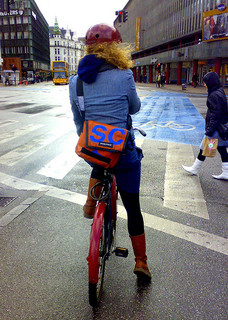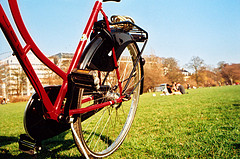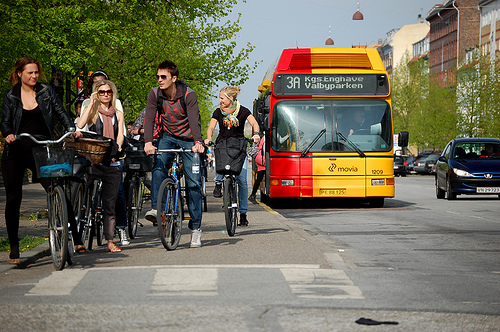I know I’m supposed to be thinking about science, but I can’t stop thinking about bikes. Last month, I was in Copenhagen, and being on a bike there seemed like more fun than it was anywhere else.
Part of it was the bike—the family we exchanged houses with had a cargo trike, complete with a skull design on the cover. Part of it was how protected riding felt—most streets had a bike lane, about as wide as a sidewalk and slightly raised or separated in some other way from the cars.
But if I had to pick just one thing that changed my biking worldview, it was the left turn.
I hate making left turns on a bike. I don’t like cutting across to the turn lane, making sure the cars behind me see me, waiting for the opening, hoping that a car behind me doesn’t spot it, too.
Left turns are problematic, even in a car. (Left turns in right-hand-traffic lands, that is. I have done my fair share of screaming and slapping my palms against the dashboard through right turns while riding shotgun in Ireland and, particularly, New Zealand. Until recently, a person making a right turn in New Zealand had the right of way over someone making an oncoming left turn, which added to my confusion).
I’m not the only one who doesn’t like making left turns. UPS has a software program that plans out delivery routes for its drivers—looking at, among other things, reducing the number of left turns (and pre-left-turn idling) its iconic brown trucks make. In 2011, route-planning technology saved 8.4 million gallons of fuel.
Even if I’m in my car, I never think about fuel efficiency as I dart across the intersection–just safety. A left turn leaves you exposed, even on four wheels. On two, the feeling’s even stronger.
So imagine my delight when I saw people on bikes in Copenhagen making left turns by going right. When you come to an intersection where you want to make a left, you stay right, begin to cross the intersection and then make a hook turn until you’re perpendicular to the way you started. (Forgive that convoluted explanation and check out these graphics instead.)
Some bikers might chafe at this way of turning. (Others will wonder why it took me so long to figure this out.) In the past, when I’ve been riding my bike somewhere, I’ve always seen myself as a failure if I needed to get off my bike and walk it, whether to negotiate an obstacle or deal with a tricky intersection. If I could really ride, wouldn’t I just stay on the bike?
In Copenhagen, I noticed people walking their bikes everywhere, as well as riding. Crossing streets, chatting with a friend on foot, window shopping, who knows why. And when I walked my bike, no one said, would that loser with the humidity-frizzed hair sticking out from the borrowed pink helmet please get back in the saddle?
Of course, there are many other advantages of riding in Copenhagen besides the left turn. There’s an extensive network of bike paths and bike lanes and even bike superhighways, and soon to be more: the city has a goal of boosting the number of people biking daily to work or school from 37% of the population to 50% by 2015 (or sometime soonish). Green wave technology allows bikers on certain routes to hit green light after green light, provided they’re going 20 kilometers an hour.
Some cities are starting to make the “Copenhagen left” part of their bike infrastructure. Salt Lake City installed a bike turn box last November for bicycles to wait while midway through their turn from Main Street to eastbound 200 S (see how they’re used here). Portland, Oregon also has several left-turn boxes; a 2011 report suggested that cyclists could make better use of these boxes in the areas studied.
There have been several studies on whether bike lanes and bike paths promote ridership. A March study in the journal Transportation said . . .well, here’s an interesting story about it. The truth is, I started to look up lots of research about bikes, and bike lanes, and left turns, but then I got a bit sidetracked. Do you think I should put this on my if-I-win-the-lottery wish list? Or this? Both, you say?
Whether I’m on my trusty ten-year-old clunker or my dream bike, I’m more likely to ride if it’s faster and more convenient than other ways to get from here to there. Particularly if it’s more fun, too. I’m really interested in reading Just Ride, a new book about (from what I’ve read) rediscovering bike bliss.
When I was on foot in Copenhagen, I spent most of my time watching all the people who were riding past. There were babies tucked into bike seats behind their parents, people in business suits and shiny shoes, friends out riding together, letter carriers on their solitary routes. One woman rode with her elderly mother in the front of her cargo bike. Something about seeing them made me want to cry.
But mostly, when I think about biking, I want to smile. I’ve been starting to dream up errands that can be done by bike, even if I’ll have to walk my bike across a street or make a U-turn to get to the destination I had in mind.
And once in a while, the fun is in throwing caution to the wind. Only once did I see someone making a “regular” left turn in Copenhagen. He was an older man, looking as if he was heading out to lunch: a button-down shirt, slacks, just the smallest wisps of gray hair standing away from his temples. His smile was wide, his hand extended like a flag as he cut to the middle of the intersection and sliced left.
What I remember most of all was his laugh—loose, high-pitched, a near-giggle that comes when you first get the feeling of wheels and speed and air whistling around your ears. And I wasn’t the only one who heard it. Everyone—the people in the cars, the people standing at the crosswalks, those walking their bikes and those riding them—seemed to pause for a moment and watch him turn.
Extras:
A video with lots of Copenhagen cycling footage from Streetfilms
Stylish Danes on bikes at Copenhagen Cycle Chic
**
Images Top: Spacing Magazine Middle: malouette Bottom: barely_legal

New Jersey has a lot of hook-turn intersections for auto traffic, and I have to say I despised them when I drove there. But, having also been an urban bike commuter, I can see a definite advantage in using them for bike traffic. Those left turns always felt like taking my life into my own hands!
Sounds like Copenhagen has a well entrenched biking infrastructure that I wished Toronto had!
@Erin, it’s so interesting, the various ways that transportation planners try to deal with making left turns safer, from roundabouts to turn arrows. I’m wondering if the New Jersey turns are like the Michigan left: http://www.michiganhighways.org/indepth/michigan_left.html
@jenbeans I wish we had it, too–I’m in withdrawal.
We just got back from Austria, where you can bike on bike paths that run next to highways, from town to town, city to city. I saw folks of all ages on bikes, and like you, it made me smile.
We just got a bike lane near my apartment, and there is no question it has improved the quality of our lives as we no longer fear for our lives as we make our way to do a loop in Central Park.
Viva la Bicycle!
Great post Cameron.
The hook turn was new to me–very clever. Thanks for sharing.
20 km/hr??!!?? Who do they think we are, Lance-freakin’-ARMSTRONG?
When I can average 10 MPH in our hilly terrain, I think I’m doing good…
Unfortunately all too often when I take my road bike out, I feel as though I’m taking my life into my hands.
cameron,
really enjoyed your article. the nostalgia the bicycle has with ppl and just the sheer enjoyment it brings and that you saw when you watched people. i could visualize myself in Copenhagen as i read your words.
i am a fan of the Copenhagen left or the double left, whatever you call it. after being hit in an intersection, i find myself holding my breath – every time i bike through one now.
@Val, that’s what I thought, too! But everywhere I rode was pretty flat, and I imagine the superhighways are the same–perhaps with time, we would get up to speed.
@jess and @christie, thanks!
Great post! During the crowded summer months here on Cape Cod, we plan all our outings based on avoiding making left turns. It’s so ingrained in my brain that even when I drive elsewhere on quiet roads, I’ll avoid them if I can and get excited when I get to turn left without waiting 5 minutes.
We spent two days in Copenhagen last summer. Loved it!